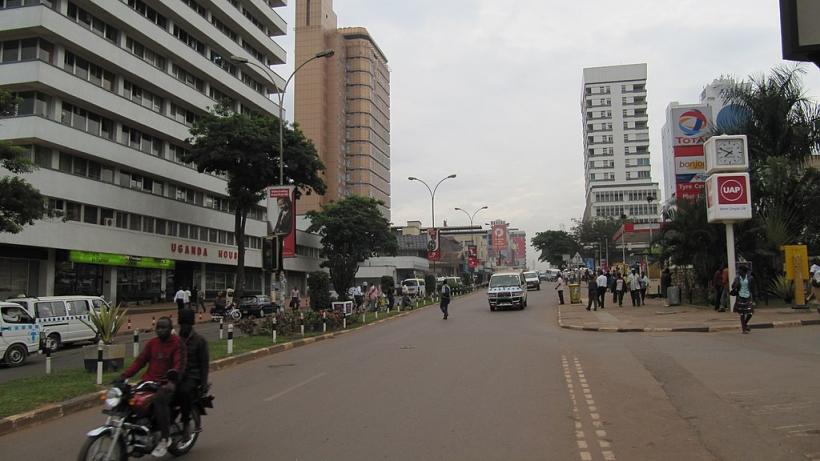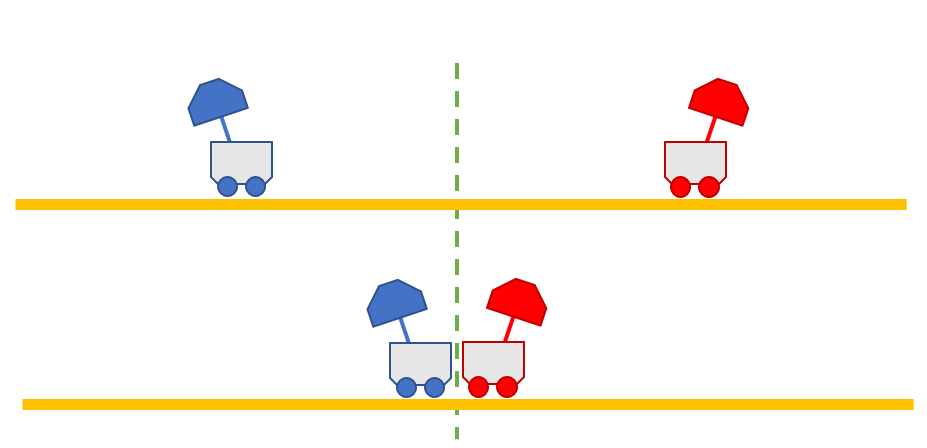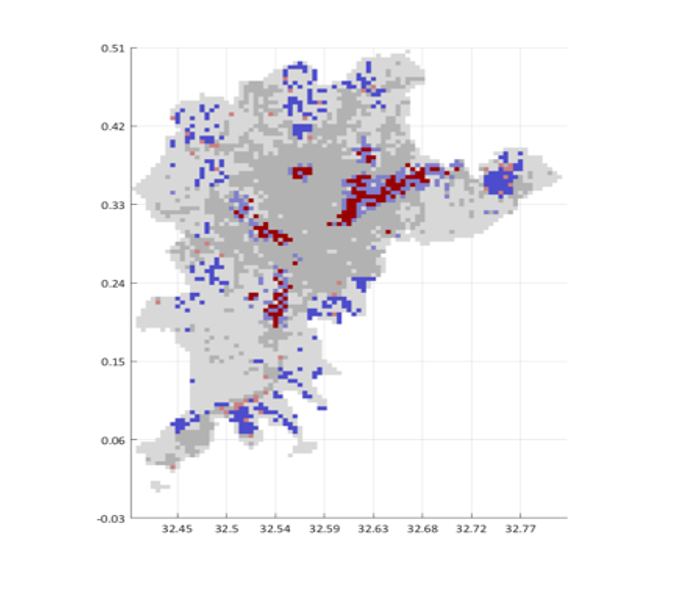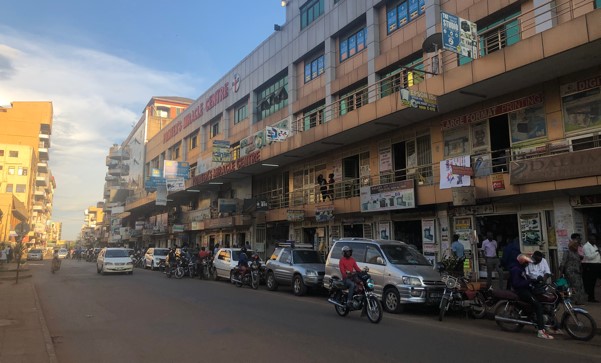
Location, location, and information: Firm clustering in Kampala
A distinctive feature of business in Kampala is the clustering of similar products in particular areas of the city. Need a boda boda helmet to get to work? On Kyagwe Road in Old Kampala you’ll find any and all vehicle parts and accessories. Art supplies? Head straight to the shops on Nasser Road in Nakasero. For furniture, there are at least ten different suppliers along Ggaba Road.
We see this across a number of cities – businesses selling similar, if not identical, products, in very close proximity in particular areas of the city. But it’s not obvious why this is the case. As a business owner, by locating right next door to your competitor, you make it easier for customers to compare products and choose who to buy from based on price and quality. This limits your ability to charge higher prices – and make higher profits. So, what’s driving this co-location of similar firms in a city?
Competing for market share: ice cream on a pier
The simplest explanation of the clustering of firms in the centre of a city is seen in Hotelling’s famous ice cream analogy. In his simple model of spatial competition, two ice cream sellers are choosing where to locate on a busy pier on which customers are spread evenly across its length. Customers choose to go to the vendors closest to them. If both vendors locate a quarter of the way alone the pier on either end, customers on one side of the pier will go to vendor A – let’s call her Amanda – and customers on the other side of the pier will go to vendor B – Bob. No customers have to travel more than a quarter of the pier, and each vendor serves half the market.
However, Bob will soon realise that by moving just a little closer to the middle of the pier, he is able to keep all of his existing customers and steal some of Amanda’s customers. Amanda has the same thought – the result is that both vendors will move to the middle of the pier, right next to each other, to avoid the other stealing part of their market.
 Hotelling’s law: Firm clustering may result from competition for market share. (Image: Priya Manwaring).
Hotelling’s law: Firm clustering may result from competition for market share. (Image: Priya Manwaring).
Using this logic, it may not seem as surprising that we see clustering of similar products in the centre of a city. But this explanation doesn’t seem to be sufficient. First – as soon as you add a few more firms into the picture, clustering in the middle of a city no longer becomes the best option for any individual firm in gaining market share. Second, products are often not identical – but similar. In these cases, it may actually do the worse quality producer good to move away from competitors.
The benefits of agglomeration
More recent evidence from developed cities instead highlights that firms benefit from being located near other similar businesses through the transfer of ideas and technology and a greater combined ability to access to finance, markets, and labour. These ‘agglomeration’ benefits may outweigh the downsides of being next to another supplier. With heavy congestion, the benefits of being located close to other firms may be even more important for cross-firm learning.
This seems a convincing explanation for why some types of businesses cluster together in Kampala – particularly manufacturing and producer service firms that stand to benefit greatly from knowledge spill-overs and personal connections with other firms. Recent research by the International Growth Centre (IGC) highlights the importance of informal rental networks between closely located small and medium sized manufacturing firms in Uganda in accessing productivity-enhancing machinery (Bassi et al., 2019).

Graph: Growing manufacturing clusters in Kampala between 2002 and 2011 (indicated by red and pink pixels): Northern clusters specialise in apparel, while the East and West specialise in food products (Bird, Hierons, and Venables, 2019). Co-location of firms is likely to offer benefits in terms of knowledge transfer and sharing of technology and suppliers.
However, it’s not clear that these effects would be as important for consumer services and retail firms, whose sales depend crucially on convenience of consumer access. For example, 84% of informal firms – who predominantly sell to households rather than other businesses – sell to customers within a 30 minute walk. For these firms, the question remains - why locate right next door to your competitor instead of spreading out across the city?
Bird and Rauch (2015) have explored the choice to cluster with similar consumer-facing firms as a trade-off firms face between offering proximity and variety to consumers. For many types of goods, consumers prefer to have a variety of options to choose from, and the gains from offering this choice to consumers may outweigh the costs of competition. But there are also costs to consumers of having to travel further to reach the cluster than if businesses were more evenly spread out. As such, firms are more likely to cluster the lower the transport costs, the less frequent the purchases, and the more variety in goods there is to choose from between firms in the cluster.
But this doesn’t seem to fit the kind of clustering we see in Kampala, with high costs of congestion and minimal differentiation between products on offer on the same street. The gains from ‘variety’ on offer to consumers also seem limited.
 A row of art supply shops on Nasser Road, Kampala (Photo: Priya Manwaring)
A row of art supply shops on Nasser Road, Kampala (Photo: Priya Manwaring)
The power of knowledge
One potential missing piece to this story is an additional benefit of agglomeration in developing cities – information. Clustering offers customers information both on location and on quality, particularly for goods that are bought less frequently. By clustering together, consumers know where to go to access their tables, notebooks, helmets – and feel confident in the quality of the products they are purchasing.
In the absence of online information on shop locations and quality, locating together may allow firms to connect with customers that they would otherwise lose out on. In this way, the losses from competition are more than made up for by the gains from an established location that customers know and can rely on.
When asked why there were so many art shops on Nasser Road, one shopkeeper responded, “because it’s Nasser Road”. Taking into account the information effects of agglomeration may help to make sense of firm clustering behaviour in Kampala.
References
Bassi, V. et al. (2019). Understanding productivity dispersion: Evidence from a new survey of manufacturing firms in Uganda, Final report, International Growth Centre. Accessible: https://www.theigc.org/wp-content/uploads/2019/09/Bassi-et-al-2019-final-report-1.pdf
Bird, J. and Rauch, F. (2015). The effects of traffic on firm location: Evidence from the Kampala bypass, University of Oxford. Accessible: http://pubdocs.worldbank.org/en/531761438982913861/04-RAUCH-Transport-Kampala-7-13-2015.pdf
Collier, P. (2016). African Urbanization: an Analytic Policy Guide, International Growth Centre. Accessible: https://www.theigc.org/wp-content/uploads/2016/01/African-UrbanizationJan2016_Collier_Formatted-1.pdf
De Haan, J. (2012). “Why do competitors open their stores next to one another?”, video, TEDEd. Accessible: https://ed.ted.com/lessons/why-do-competitors-open-their-stores-next-to-one-another-jac-de-haan
Ellison, G. et al. (2010). “What Causes Industry Agglomeration? Evidence from Coagglomeration Patterns”, American Economic Review. Accessible: https://www.aeaweb.org/articles?id=10.1257/aer.100.3.1195
World Bank (2017). From Regulators to Enablers: The Role of City Governments in Economic Development of Greater Kampala. Accessible: http://documents.worldbank.org/curated/en/860311505816462189/pdf/119806-REVISED-PUBLIC-The-wb-Book-2017-Report-web-Individual-Page-Layout.pdf

